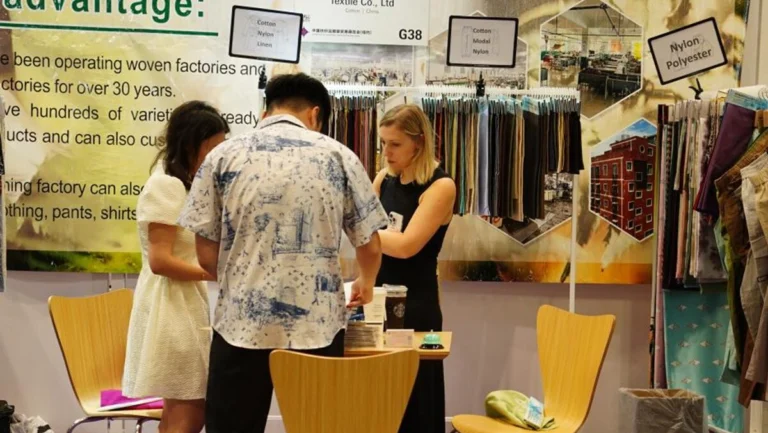Trump’s Tariff Games Darkens the Outlook for the U.S. Apparel Supply Industry

Texworld NYC, the largest textile sourcing trade show on the U.S. East Coast, July 23, 2025. Photo: Xinhua
July 24, 2025 Hour: 10:19 am
‘Uncertainty is the word that everyone uses,’ said Julia Hughes, president of the U.S. Fashion Industry Association.
Ongoing tariff uncertainty is putting pressure on U.S. textile and apparel firms, as sourcing executives warn that the lack of clear trade rules is complicating supply chain planning, pricing strategies and diversification efforts.
RELATED:
Italian Industry Warns Trump’s Tariffs Could Undermine Growth
“I would say uncertainty is the word that everyone uses to say how it’s difficult to make decisions when there is so much uncertainty in the supply chain,” said Julia Hughes, president of the U.S. Fashion Industry Association, during a panel discussion Wednesday at Texworld NYC, the largest textile sourcing trade show on the U.S. East Coast.
Hughes noted that importers, customs brokers and buyers are grappling with unanswered questions. “It’s kind of scary talking to the brokers and the folks who are filing their entries — how this will proceed is something we just don’t know,” she said. “How it’s going to be managed and how it’s going to be handled by customs is unknown.”
The Trump administration’s latest round of tariffs on a wide range of imports is slated to take effect on Aug. 1, leaving limited time for negotiations. Yet, few countries have secured new trade agreements with Washington, and many of the ongoing discussions lack detail — a situation that has left many firms in limbo, according to industry insiders.
“I think everyone recognizes they need to diversify, probably location and maybe vendors,” said Hughes. “But they’re not yet pulling the trigger on where to diversify to, until we see what the tariffs are.”
Even when companies decide to diversify, the process is far from immediate. “You can’t certify a new factory overnight. That takes a long time,” she said. “There’s a lot of issues, not just on quality and the product, but also on compliance and logistics. So that’s going to take a while as well.”
The impact on costs is also becoming more evident. “The kind of self-evident point is that, obviously, prices are going to go up,” she added.
Laura Siegel Rabinowitz, a trade lawyer and shareholder at Greenberg Traurig, said importers are already feeling the pinch of existing tariffs. “The retailers that I work with are tracking their increased costs, their increased tariff payments, monthly, quarterly, and the numbers are astounding. It’s very high,” she said.
Hughes noted that fashion brands are already delaying or canceling orders, with negotiations now centered on who bears the cost of tariffs. “Everyone has been affected by the tariffs already, because orders have not been placed, things have been held back, negotiations with suppliers on who pays the tariffs.”
While there is interest in revitalizing U.S.-based apparel manufacturing, structural challenges remain. Hughes shared a recent case of a buyer comparing options in Bangladesh, China and the United States. “They found somebody in the United States who was really good, but the price was double. The price was too high for them in the short term to make that shift.”
Still, some companies are trying to remain flexible despite the uncertainties. Chris Warren, vice president of sales and merchandising at menswear brand Turtleson, said that uncertainty around tariffs continues to complicate sourcing decisions.
“There are so many unknowns about the tariffs that we try not to think too much about it. We look for unique items we like, and then figure out the pricing,” he said, adding that while his company has no fixed pricing strategy due to the ongoing uncertainty, it remains open to modest cost increases if the product is innovative and marketable.
Elena Brandyberry, founder and CEO of her namesake brand, echoed the challenges. “It’s very complicated,” she said, noting that higher costs could lead to either cutting corners or raising retail prices. “Everything is going to be more expensive, so we need to be prepared to produce better products with good quality.”
teleSUR/ JF
Source: Xinhua

